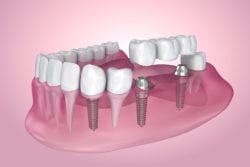 In addition to negatively affecting your self-esteem, missing teeth can cause a multitude of problems, from difficulty speaking normally to difficulty eating and poor nutrition. Fortunately, the world of dentistry has several excellent methods of tooth replacement. One of the most simple and reliable methods available is also one of the most long-established: the dental bridge.
In addition to negatively affecting your self-esteem, missing teeth can cause a multitude of problems, from difficulty speaking normally to difficulty eating and poor nutrition. Fortunately, the world of dentistry has several excellent methods of tooth replacement. One of the most simple and reliable methods available is also one of the most long-established: the dental bridge.
Columbia, SC dentist Dr. Tom Trinkner wants to take a moment to explain the benefits of dental bridges for restoring your smile to its natural appearance and full functionality.
What is a Dental Bridge?
A bridge is a type of prosthesis (replacement part) that replaces a missing tooth and is supported by the adjacent healthy teeth. In dental terms, the artificial replacement tooth is a “pontic” (from the French word “pont” meaning bridge), while the healthy adjacent teeth that support it are known as abutments. The completed prosthesis crosses over the gap in your teeth just like a bridge spanning a canyon.
The teeth that will be used as the abutments must be specially prepared to support the pont by being crowned or “capped.” This process is completed exactly as if the teeth were being crowned due to tooth decay or damage.
Their outer layer of enamel is removed to allow the crown to fit over and completely cover them while still appearing lifelike. Three connected crowns are placed, one one each side of the gap in your smile (the abutments) with a pontic in between. The pontic is another crown but without a tooth living underneath.
Building a Bridge
As previously explained, if you have one missing tooth, your bridge will be constructed of three connected crowns: two to cover the abutment teeth on either side of the gap left by the missing tooth and one in between. This design is known as a three-unit bridge.
If more than one tooth is missing, more crowns (and possibly more abutment teeth) may be required to create the bridge. Your dentist calculates this by considering the number of teeth missing, the size, length and stability of the abutment tooth roots, and also from where in the mouth the teeth were lost.
So if you are missing three teeth, four teeth may be necessary to serve as the abutment, thereby creating a seven-tooth bridge. Engineering and designing dental bridges requires an understanding of the biology of the tooth-supporting gum and bone tissue as well as how to replace teeth.
What to Expect
Having a bridge completed usually requires two separate dental visits. At the first visit, local anesthetic will be administered and your abutment teeth will have their outer layers of enamel removed as previously described. Molds will be taken by your dentist of your prepared teeth to create three-dimensional models which will be used to construct the crowns. A temporary bridge will be placed before you leave the office. You will have to return again for your permanent restoration to be placed.
When your permanent bridge is ready, you will come back for another visit to your dentist for placement. You may need time to become accustomed to the feel of the new bridge against your tongue, lips, and cheeks, but will eventually come to accept it as part of your own teeth.
Caring for your Bridge
Crowned teeth require the same faithful hygiene as your other teeth. Dentists recommend brushing twice daily and flossing every day to reduce the build-up of dental plaque. Flossing will be slightly more challenging with a dental bridge as you will have to thread the floss under the connected crowns in order to clean between them. It is even more important for you to attend routine examinations and cleanings with your dental provider if you have a dental bridge. A bridge that is properly cared for can last for up to 10 years.
Dental Bridges in Columbia, SC
If you are in the Columbia, SC area and would like to discuss tooth replacement options with a skilled professional dentist or even just have a routine teeth cleaning, call 803-400-8729 or schedule online with Dr. Tom Trinkner today.
